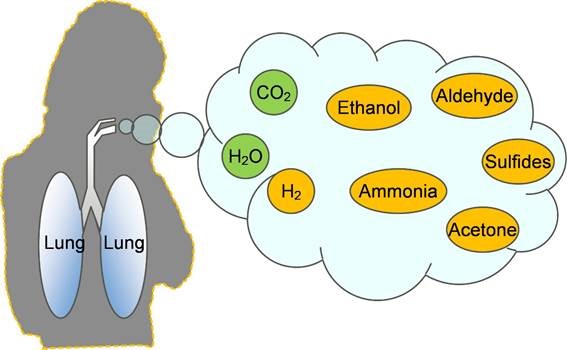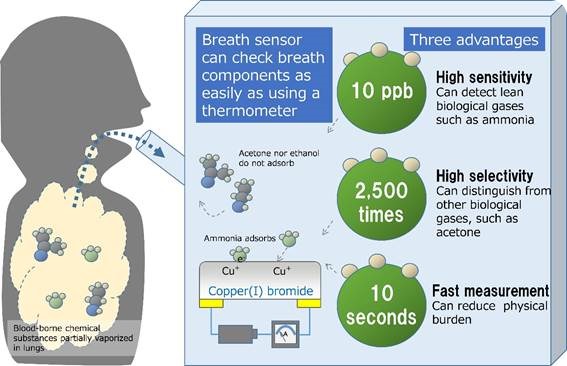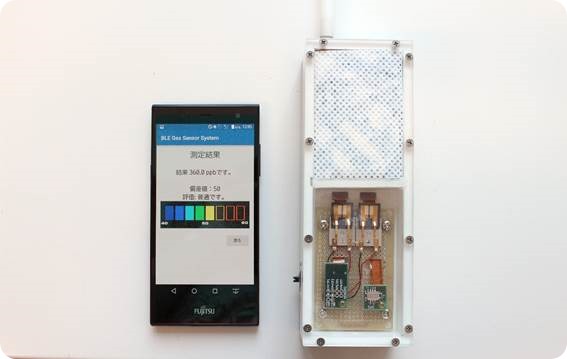Generally, it is thought that there is a connection between concentrations of ammonia and liver disease, such as fatty liver and cirrhosis, Helicobacter pylori (H. pylori) infection, and kidney failure.
Moreover, the correlation between these diseases and other illnesses, such as hypertension, is high. Similarly, links between acetone and obesity and diabetes are reported. Also, research is being conducted extensively for the early discovery of cancers, including lung cancer, using volatile organic compounds (VOC).

Conceptual image of component gases in a person's breath
Research linking concentrations of these gases with illnesses is carried out at medical research institutions. Fujitsu Laboratories has reached the stage of having developed technology that measures the concentration of ammonia in the breath. Medical research is the next step.
What are the main challenges with analyzing breath components?
Human breath contains more than 200 gas compounds. These compounds include gases found in the atmosphere environment and in the mouth, as well as those compounds in the blood that are vaporized in the lungs. These compounds and proportions vary by individual.
Also, as gases with similar chemical characteristics of reduction (and gases with similar molecular weights) coexist, it is difficult to distinguish between and measure them using a gas sensor.
The electronic nose method, with which numerous gas sensors are used to analyze response patterns, is comparatively quick; however, it does not fundamentally solve the above problems.
For the accurate analyses of these gases, it has been necessary for a trained operator to spend substantial time conducting measurements with expensive, large scale analysis equipment, such as gas chromatography. As such, there has been want for small, quick analysis devices.
Moreover, in slow analysis methods, the breath is captured in a bag for analysis with the equipment. But, as the breath is very humid, condensation forms on the inner surface of the bag once the temperature of the contents of the bag decreases below body temperature. Particularly, ammonia as a gas is a highly soluble compound in water, which causes its concentration to drop quickly, resulting in inaccurate measurements.
Can you please outline the portable breath sensor that Fujitsu Laboratories have developed? How does the technology overcome these challenges?
Ammonia is contained in the breath of everyone. As such, we at Fujitsu Laboratories decided that we should develop a breath sensor that accurately measures ammonia.
After investigating a range of materials, we chose copper(I) bromide for its ability to selectively adsorb molecules of ammonia and because during this adsorption an electrical change occurs. This allowed us to develop a unique gas sensor device.

The new sensor device and a cross-sectional electron-microscope photo of the copper(I) bromide film
Unlike with common gas sensors, such as ones using tin oxide or an electrochemical approach, ammonia molecules are not decomposed or forced to react; therefore, the sensor, according to the properties of copper(I) bromide, hardly responds to gases other than ammonia, enabling measurements with a never-before-seen level of selectivity.
We also developed an algorithm for measuring by the rate of change of resistance, which allows measurements to be completed in just 10 seconds. With this tech, the patient needs only to exhale directly into the device, without a collection bag, for measurement.
How sensitive is the technology?
The technology quantitatively measures ammonia in the breath in a range from 10 parts per billion to several parts per million. Meanwhile, its sensitivity to other gases is extremely low, responding hardly at all.
In other words, selectivity towards ammonia is extremely high. For example, the sensitivity differential with acetone, which is often found in the breath, is about 2,500 times.

Operation principles and advantages of the newly developed breath sensor
What is nonanal and how did Fujitsu Laboratories manage to selectively detect it?
Nonanal is an aldehyde compound with the chemical formula C9H18O. Aldehydes with a high carbon count, such as nonanal, are often found on the breath of persons suffering from lung cancer, as has been reported in various medical research.
By forming an extremely thin tertiary amine film on the surface of the copper(I) bromide and modifying the copper(I) bromide to improve affinity with aldehydes, we succeeded at selectively detecting nonanal.
Currently the technology is capable of detecting nonanal at concentrations of 200 ppb, which is a lower sensitivity than the ammonia sensor. The response is also slower. We will continue with technological improvements before adding the tech to our breath sensor.
Do you plan to increase the types of gases the technology can measure? Which gases do you plan to focus on and why?
After ammonia, the next common, biological gas that we plan to support is acetone. In the field of biochemistry, starting with ammonia and acetone, there are many kinds of gases originating in the body for which the generation (metabolic) mechanism has been established. We plan to increase the kinds of gases that can be measured, focusing on these gases.

Fujitsu's prototype breath sensor, displaying results on a smartphone. (On-screen text, top to bottom) Measurement Results, Result: 360.0 ppb, Deviation value: 50, Evaluation: Normal
How important do you think breath analysis will be in the future of detecting lifestyle diseases?
Patients in Japan are often subject to long waits at clinics, and treatments and test items are often decided after a brief examination. Wait times increase when the patient requires further testing.
A concern is that as Japan becomes an increasingly aged society demographically, this trend will continue to worsen. It is our hope that by measuring gas compounds on the breath during the patient's initial wait, breath conditions can be used as a source of vital-sign information during the examination, which could improve the efficiency of diagnoses and more in-depth testing.
We feel that to enable the above usage, the breath analysis must be convenient—easy to hold, easy to use, and offering a result quickly. Once the sensor is sufficiently convenient, persons not diagnosed as ill can easily measure their breath components, which we expect will aid the early discovery of lifestyle diseases.
What are Fujitsu Laboratories’ future plans in terms of developing this technology?
Our aim is to develop a product that is used in clinical practice. To achieve this goal, we are continuing the development of the technology. As well, we are seeking collaboration with medical research institutes. The search is ongoing and we invite responses from interested institutions.
In terms of timescales, when do you think we’re likely to see breath analysis technology being used in a clinical setting?
We plan to start gathering the clinical data required for the certification of medical devices from 2018.
Where can readers find more information?
We invite your readers to see the press release, or contact us via e-mail.
About Osamu Tsuboi
Osamu is a Research Manager in Fujitsu Laboratories' Devices & Materials Laboratory.
He received a B.E. in Mechatronics from Toyota Technological Institute in 1992. After joining Fujitsu Limited, he was involved in the development of ULSI memories, including 128M-DRAM. In 2001, he joined Fujitsu Laboratories Ltd., working on the development of MEMS micromirror arrays, such as wavelength selective switches for optical-telecommunications. From 2009, he conducted research on sensing devices and energy harvesters for IoT. Currently, he researches vital sensing technologies for medicine and healthcare.